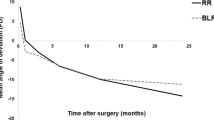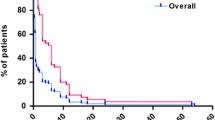Abstract
Purpose
To evaluate the long-term surgical outcome of patients with consecutive exotropia.
Methods
Patients who underwent surgery for the treatment of consecutive exotropia between January 2008 and July 2016 with a minimum follow-up period of 2 years were retrospectively reviewed. Surgical outcomes were classified based on postoperative angle of deviation at 2 years as follows: success (esodeviation ≤ 5 prism diopters [PD] to exodeviation ≤ 10 PD), and recurrence [exodeviation > 10 PD]). Postoperative angles of deviation at 1 week, 1 month, 6 months, 1 year, and 2 years and at the final follow-up were investigated.
Results
A total of 37 patients (28 in the success group and 9 in the recurrence group) were included. Surgical success rate at 2 years was 75.7%, and reoperation rate was 10.8% during a mean follow-up period of 42.4 ± 18.3 months after consecutive exotropia surgery. After surgery, exodrift occurred mostly during 1-month follow-up in both groups, and those with no exodrift within 1 month presented a higher surgical success. Thereafter, patients in the success group showed a more stable course during follow-up than those in the recurrence group. Stereopsis was an important factor associated with surgical outcome.
Conclusions
Exodrift occurs mostly within 1 month after surgery for consecutive exotropia. Targeting initial overcorrection and establishing esodeviation at postoperative month 1 is important to achieve successful results.


Similar content being viewed by others
References
Ganesh A, Pirouznia S, Ganguly SS, Fagerholm P, Lithander J (2011) Consecutive exotropia after surgical treatment of childhood esotropia: a 40-year follow-up study. Acta Ophthalmol 89(7):691–695. https://doi.org/10.1111/j.1755-3768.2009.01791.x
Donaldson MJ, Forrest MP, Gole GA (2004) The surgical management of consecutive exotropia. J AAPOS 8(3):230–236. https://doi.org/10.1016/s1091853104000047
Stager DR, Weakley DR Jr, Everett M, Birch EE (1994) Delayed consecutive exotropia following 7-millimeter bilateral medial rectus recession for congenital esotropia. J Pediatr Ophthalmol Strabismus 31(3):147–150 discussion 151-142
Keskinbora KH, Pulur NK (2004) Long-term results of bilateral medial rectus recession for congenital esotropia. J Pediatr Ophthalmol Strabismus 41(6):351–355
Caputo AR, Guo S, Wagner RS, Picciano MV (1990) Preferred postoperative alignment after congenital esotropia surgery. Ann Ophthalmol 22(7):269–272
Yurdakul NS, Ugurlu S (2013) Analysis of risk factors for consecutive exotropia and review of the literature. J Pediatr Ophthalmol Strabismus 50(5):268–273. https://doi.org/10.3928/01913913-20130430-01
Folk ER, Miller MT, Chapman L (1983) Consecutive exotropia following surgery. Br J Ophthalmol 67(8):546–548
Sawada M, Hikoya A, Negishi T, Hotta Y, Sato M (2015) Characteristics and surgical outcomes of consecutive exotropia of different etiologies. Jpn J Ophthalmol 59(5):335–340. https://doi.org/10.1007/s10384-015-0395-z
Taylan Sekeroglu H, Erkan Turan K, Karakaya J, Sener EC, Sanac AS (2016) Clinical risk factors for the development of consecutive exotropia: a comparative clinical study. Int J Ophthalmol 9(6):886–889. https://doi.org/10.18240/ijo.2016.06.17
Bradbury JA, Doran RM (1993) Secondary exotropia: a retrospective analysis of matched cases. J Pediatr Ophthalmol Strabismus 30(3):163–166
Mohan K, Sharma A, Pandav SS (2006) Unilateral lateral rectus muscle recession and medial rectus muscle resection with or without advancement for postoperative consecutive exotropia. J AAPOS 10(3):220–224. https://doi.org/10.1016/j.jaapos.2006.01.182
Chatzistefanou KI, Droutsas KD, Chimonidou E (2009) Reversal of unilateral medial rectus recession and lateral rectus resection for the correction of consecutive exotropia. Br J Ophthalmol 93(6):742–746. https://doi.org/10.1136/bjo.2007.127613
Rajavi Z, Feizi M, Mughadasifar H, Yaseri M, Haftabadi N, Sheibani K (2013) Surgical results of consecutive exotropia. J Pediatr Ophthalmol Strabismus 50(5):274–281. https://doi.org/10.3928/01913913-20130730-03
Kasi SK, Tamhankar MA, Pistilli M, Volpe NJ (2013) Effectiveness of medial rectus advancement alone or in combination with resection or lateral rectus recession in the management of consecutive exotropia. J AAPOS 17(5):465–470. https://doi.org/10.1016/j.jaapos.2013.06.016
Cho YA, Ryu WY (2013) The advancement of the medial rectus muscle for consecutive exotropia. Can J Ophthalmol 48(4):300–306. https://doi.org/10.1016/j.jcjo.2013.03.003
Gesite-de Leon B, Demer JL (2014) Consecutive exotropia: why does it happen, and can medial rectus advancement correct it? J AAPOS 18(6):554–558. https://doi.org/10.1016/j.jaapos.2014.08.004
Plager DA, Parks MM (1990) Recognition and repair of the “lost” rectus muscle. A report of 25 cases. Ophthalmology 97(1):131–136 discussion 136-137
Ludwig IH, Chow AY (2000) Scar remodeling after strabismus surgery. J AAPOS 4(6):326–333. https://doi.org/10.1067/mpa.2000.107899
Hatt SR, Leske DA, Jung JH, Holmes JM (2017) Intraoperative findings in consecutive exotropia with and without adduction deficit. Ophthalmology 124(6):828–834. https://doi.org/10.1016/j.ophtha.2017.01.031
Birch EE, Stager DR Sr, Berry P, Leffler J (2004) Stereopsis and long-term stability of alignment in esotropia. J AAPOS 8(2):146–150. https://doi.org/10.1016/s1091853103003124
Birch EE, Stager DR Sr (2006) Long-term motor and sensory outcomes after early surgery for infantile esotropia. J AAPOS 10(5):409–413. https://doi.org/10.1016/j.jaapos.2006.06.010
Pediatric Eye Disease Investigator Group (2002) Spontaneous resolution of early-onset esotropia: experience of the Congenital Esotropia Observational Study. Am J Ophthalmol 133(1):109–118
Mangla D, Simon JW, Mangla N, Zobal-Ratner J (2014) Treatment of consecutive exotropia: unilateral lateral rectus recession combined with medial rectus advancement or resection. J Pediatr Ophthalmol Strabismus 51(2):116–119. https://doi.org/10.3928/01913913-20140205-03
Marcon GB, Pittino R (2011) Dose-effect relationship of medial rectus muscle advancement for consecutive exotropia. J AAPOS 15(6):523–526. https://doi.org/10.1016/j.jaapos.2011.08.011
Funding
This work was supported by the National Research Foundation of Korea (NRF) Grant funded by the Korean Government (MOE) (No. 2017R1D1A1B03032985). The grant had no role in the design or conduct of this research.
Author information
Authors and Affiliations
Corresponding author
Ethics declarations
Conflicts of interest
The authors declare that they have no conflict of interest.
Ethical approval
All procedures performed in studies involving human participants were in accordance with the ethical standards of the institutional and/or national research committee and with the 1964 Helsinki declaration and its later amendments or comparable ethical standards.
Informed consent
For this type of study, formal consent is not required. The Institutional Review Board of Seoul National University Hospital in South Korea granted a waiver of consent for this retrospective chart review study.
Additional information
Publisher’s note
Springer Nature remains neutral with regard to jurisdictional claims in published maps and institutional affiliations.
Rights and permissions
About this article
Cite this article
Lee, HJ., Yu, Y.S. & Kim, SJ. Long-term surgical outcomes of patients with consecutive exotropia. Graefes Arch Clin Exp Ophthalmol 257, 1037–1044 (2019). https://doi.org/10.1007/s00417-019-04293-3
Received:
Revised:
Accepted:
Published:
Issue Date:
DOI: https://doi.org/10.1007/s00417-019-04293-3




